Walnut Shell Pretreatment in Regard to Its Combustion Properties
Abstract
1. Introduction
2. Materials and Methods
3. Results and Discussion
4. Conclusions
- -
- Solid fuel made from walnut shells is suitable for combustion in domestic boilers to obtain heat.
- -
- Pellets from waste biomass can compete with traditional pellets currently available on the energy market.
- -
- Properly carried out, the drying process can further raise the efficiency of the fuel by increasing the calorific value of the utilized material.
- -
- The greatest improvement to materials comes from selecting an optimal drying cycle with individually adjusted time and temperature intervals depending on the material being used. In the case of walnut shells, the most favorable condition is within a time interval of 90 min and a temperature of 110 °C.
- -
- The elemental analysis results are comparable for both walnut shell pellets and conventional pellets, especially for CHS. Slight differences were observed for nitrogen.
- -
- Emissions of harmful oxides and compounds during combustion of the produced fuel are comparable to that of the conventional pellets.
- -
- The slight atmospheric pollution resulting from the use of biomass waste is outweighed by the small cost associated with the acquisition of the material and the actual process of fuel production.
Author Contributions
Funding
Institutional Review Board Statement
Informed Consent Statement
Data Availability Statement
Conflicts of Interest
References
- Gasparotto, J.; Da Boit Martinello, K. Coal as an energy source and its impacts on human health. Energy Geosci. 2021, 2, 113–120. [Google Scholar] [CrossRef]
- Hendryx, M.; Zullig, K.J.; Luo, J. Impacts of Coal Use on Health. Annu. Rev. Public Health 2020, 41, 397–415. [Google Scholar] [CrossRef]
- Łuszczyk, M.; Sulich, A.; Siuta-Tokarska, B.; Zema, T.; Thier, A. The development of electromobility in the european union: Evidence from Poland and cross-country comparisons. Energies 2021, 14, 8247. [Google Scholar] [CrossRef]
- Ghosh, S.K. Fossil Fuel Consumption Trend and Global Warming Scenario: Energy Overview. Glob. J. Eng. Sci. 2020, 5, 5–9. [Google Scholar] [CrossRef]
- Abas, N.; Kalair, A.; Khan, N. Review of fossil fuels and future energy technologies. Futures 2015, 69, 31–49. [Google Scholar] [CrossRef]
- Mahmoud, M.; Ramadan, M.; Naher, S.; Pullen, K.; Olabi, A.G. The impacts of different heating systems on the environment: A review. Sci. Total Environ. 2021, 766, 142625. [Google Scholar] [CrossRef]
- Konopelko, A.; Kostecka-Tomaszewska, L.; Czerewacz-Filipowicz, K. Rethinking EU Countries’ Energy Security Policy Resulting from the Ongoing Energy Crisis: Polish and German Standpoints. Energies 2023, 16, 5132. [Google Scholar] [CrossRef]
- Liadze, I.; Macchiarelli, C.; Mortimer-Lee, P.; Sanchez Juanino, P. Economic costs of the Russia-Ukraine war. World Econ. 2023, 46, 874–886. [Google Scholar] [CrossRef]
- Stala-Szlugaj, K.; Grudziński, Z. Alternative directions of coal supply to Poland as a result of the Russian-Ukrainian war. Gospod. Surowcami Miner./Miner. Resour. Manag. 2022, 38, 31–47. [Google Scholar] [CrossRef]
- Rahayu, N. Market Reaction to the Announcement of the European Union Coal Embargo on Coal Import from Russia in Other Exporting Countries. J. Integr. Manag. Stud. 2023, 1, 107–123. [Google Scholar] [CrossRef]
- Ali, M.; Seraj, M.; Alper, E.; Tursoy, T.; Uktamov, K.F. Russia-Ukraine war impacts on climate initiatives and sustainable development objectives in top European gas importers. Environ. Sci. Pollut. Res. 2023, 30, 96701–96714. [Google Scholar] [CrossRef]
- Zhou, X.Y.; Lu, G.; Xu, Z.; Yan, X.; Khu, S.T.; Yang, J.; Zhao, J. Influence of Russia-Ukraine War on the Global Energy and Food Security. Resour. Conserv. Recycl. 2023, 188, 106657. [Google Scholar] [CrossRef]
- Nagaj, R.; Korpysa, J. Impact of COVID-19 on the level of energy poverty in Poland. Energies 2020, 13, 4977. [Google Scholar] [CrossRef]
- Elżbieta Kawecka-Wyrzykowska. Wyzwania Dekarbonizacji Polskiej Gospodarki: Rola Węgla. Społeczeństwo Polityka 2022, 4, 67–90. [Google Scholar] [CrossRef]
- Mielcarek-Bocheńska, P.; Rzeźnik, W. Greenhouse Gas Emissions from Agriculture in EU Countries—State and Perspectives. Atmosphere 2021, 12, 1396. [Google Scholar] [CrossRef]
- Bala-Litwiniak, A.; Musiał, D.; Nabiałczyk, M. Computational and Experimental Studies on Combustion and Co-Combustion of Wood Pellets with Waste Glycerol. Materials 2023, 16, 7156. [Google Scholar] [CrossRef] [PubMed]
- Bańka, M.; Salwin, M.; Kukurba, M.; Rychlik, S.; Kłos, J.; Sychowicz, M. Start-Up Accelerators and Their Impact on Sustainability: Literature Analysis and Case Studies from the Energy Sector. Sustainability 2022, 14, 13397. [Google Scholar] [CrossRef]
- Perera, F. Pollution from fossil-fuel combustion is the leading environmental threat to global pediatric health and equity: Solutions exist. Int. J. Environ. Res. Public Health 2018, 15, 16. [Google Scholar] [CrossRef]
- Hassan, A.; Ilyas, S.Z.; Jalil, A.; Ullah, Z. Monetization of the environmental damage caused by fossil fuels. Environ. Sci. Pollut. Res. 2021, 28, 21204–21211. [Google Scholar] [CrossRef]
- Cop, K. Wyzwania sektora energii w kontekście transformacji energetycznej. Stud. Pr. Prawnicze Adm. Ekon. 2023, 43, 69–91. [Google Scholar] [CrossRef]
- Surówka, A. Problemy i wyzwania prognozowania produkcji energii elektrycznej z OZE w Polsce w kontekście współczesnych kryzysów. Nierówności Społeczne Wzrost Gospod. 2023, 134–151. [Google Scholar] [CrossRef]
- Piwowar, A.; Dzikuć, M. Water Energy in Poland in the Context of Sustainable Development. Energies 2022, 15, 7840. [Google Scholar] [CrossRef]
- Bala-Litwiniak, A.; Musiał, D. Computational and Experimental Studies of Selected Types of Biomass Combustion in a Domestic Boiler. Materials 2022, 15, 4826. [Google Scholar] [CrossRef]
- Radomiak, H.; Bala-Litwiniak, A.; Zajemska, M.; Musiał, D. Numerical prediction of the chemical composition of gas products at biomass combustion and co-combustion in a domestic boiler. E3S Web Conf. 2017, 14, 2043. [Google Scholar] [CrossRef]
- Chomać-Pierzecka, E.; Kokiel, A.; Rogozińska-Mitrut, J.; Sobczak, A.; Soboń, D.; Stasiak, J. Analysis and Evaluation of the Photovoltaic Market in Poland and the Baltic States. Energies 2022, 15, 669. [Google Scholar] [CrossRef]
- Ogórek, M.; Bala-Litwiniak, A. Green-strategic analysis of the use of pellets from selected wood and waste materials for heating purposes. Gospod. Mater. Logistyka 2024, 2024, 39–49. [Google Scholar] [CrossRef]
- Coppola, G.; Costantini, M.; Fusi, A.; Ruiz-Garcia, L.; Bacenetti, J. Comparative life cycle assessment of conventional and organic hazelnuts production systems in Central Italy. Sci. Total Environ. 2022, 826, 154107. [Google Scholar] [CrossRef]
- Manterola-Barroso, C.; Padilla Contreras, D.; Ondrasek, G.; Horvatinec, J.; Gavilán CuiCui, G.; Meriño-Gergichevich, C. Hazelnut and Walnut Nutshell Features as Emerging Added-Value Byproducts of the Nut Industry: A Review. Plants 2024, 13, 1034. [Google Scholar] [CrossRef]
- Kumar, A.; Dangi, G.; Kumar, P.; Sharma, D.P.; Sharma, G.; Sajwan, P.; Dogra, R.K.; Gundogdu, M. Exploring pollination mechanisms in walnut: Production and breeding perspectives. S. Afr. J. Bot. 2024, 171, 673–681. [Google Scholar] [CrossRef]
- Di Pierro, E.A.; Franceschi, P.; Endrizzi, I.; Farneti, B.; Poles, L.; Masuero, D.; Khomenko, I.; Trenti, F.; Marrano, A.; Vrhovsek, U.; et al. Valorization of Traditional Italian Walnut (Juglans regia L.) Production: Genetic, Nutritional and Sensory Characterization of Locally Grown Varieties in the Trentino Region. Plants 2022, 11, 1986. [Google Scholar] [CrossRef]
- Guiné, R.; Correia, P. Hazelnut: A Valuable Resource. Int. J. Food Eng. 2020, 6, 67–72. [Google Scholar] [CrossRef]
- Zhao, J.; Wang, X.; Lin, H.; Lin, Z. Hazelnut and its by-products: A comprehensive review of nutrition, phytochemical profile, extraction, bioactivities and applications. Food Chem. 2023, 413, 135576. [Google Scholar] [CrossRef]
- Cakmak-Arslan, G. Monitoring of Hazelnut oil quality during thermal processing in comparison with extra virgin olive oil by using ATR-FTIR spectroscopy combined with chemometrics. Spectrochim. Acta Part A Mol. Biomol. Spectrosc. 2022, 266, 120461. [Google Scholar] [CrossRef] [PubMed]
- Król, K.; Gantner, M.; Piotrowska, A. The quality characteristic and fatty acid profile of cold-pressed hazelnut oils during nine months of storage. Agronomy 2021, 11, 2045. [Google Scholar] [CrossRef]
- Matin, A.; Brandić, I.; Voća, N.; Bilandžija, N.; Matin, B.; Jurišić, V.; Špelić, K.; Antonović, A.; Grubor, M.; Krička, T. Influence of Conduction Drying on the Physical and Combustion Properties of Hazelnut Shell. Energies 2023, 16, 1297. [Google Scholar] [CrossRef]
- Solís, A.; Rocha, S.; König, M.; Adam, R.; Garcés, H.O.; Candia, O.; Muñoz, R.; Azócar, L. Preliminary assessment of hazelnut shell biomass as a raw material for pellet production. Fuel 2023, 333, 126517. [Google Scholar] [CrossRef]
- Fuso, A.; Risso, D.; Rosso, G.; Rosso, F.; Manini, F.; Manera, I.; Caligiani, A. Potential Valorization of Hazelnut Shells through Extraction, Purification and Structural Characterization of Prebiotic Compounds: A Critical Review. Foods 2021, 10, 1197. [Google Scholar] [CrossRef]
- Marcuello, C.; Foulon, L.; Chabbert, B.; Aguié-Béghin, V.; Molinari, M. Atomic force microscopy reveals how relative humidity impacts the Young’s modulus of lignocellulosic polymers and their adhesion with cellulose nanocrystals at the nanoscale. Int. J. Biol. Macromol. 2020, 147, 1064–1075. [Google Scholar] [CrossRef]
- Yu, Y.; Ma, T.; Wang, S.; Jiang, M.; Gao, S.; Guo, Y.; Jiang, T.; Doumbia, B.S.; Yan, B.; Shen, S. Study on the Powder-Spreading Process of Walnut Shell/Co-PES Biomass Composite Powder in Additive Manufacturing. Materials 2023, 16, 4295. [Google Scholar] [CrossRef]
- Di Michele, A.; Pagano, C.; Allegrini, A.; Blasi, F.; Cossignani, L.; Raimo, E.; Faieta, M.; Oliva, E.; Pittia, P.; Primavilla, S.; et al. Hazelnut Shells as Source of Active Ingredients: Extracts Preparation and Characterization. Molecules 2021, 26, 6607. [Google Scholar] [CrossRef]
- Çöpür, Y.; Güler, C.; Taşçioǧlu, C.; Tozluoǧlu, A. Incorporation of hazelnut shell and husk in MDF production. Bioresour. Technol. 2008, 99, 7402–7406. [Google Scholar] [CrossRef] [PubMed]
- Puliga, F.; Leonardi, P.; Minutella, F.; Zambonelli, A.; Francioso, O. Valorization of Hazelnut Shells as Growing Substrate for Edible and Medicinal Mushrooms. Horticulturae 2022, 8, 214. [Google Scholar] [CrossRef]
- Borkowska, A.; Klimek, K.; Maj, G.; Kapłan, M. Analysis of the Energy Potential of Hazelnut Husk Depending on the Variety. Energies 2024, 17, 3933. [Google Scholar] [CrossRef]
- Jeníček, L.; Tunklová, B.; Malaťák, J.; Velebil, J.; Malaťáková, J.; Neškudla, M.; Hnilička, F. The Impact of Nutshell Biochar on the Environment as an Alternative Fuel or as a Soil Amendment. Materials 2023, 16, 2074. [Google Scholar] [CrossRef] [PubMed]
- Hebda, T.; Brzychczyk, B.; Francik, S.; Pedryc, N. Evaluation of suitability of hazelnut shell energy for production of biofuels. In Proceedings of the Engineering for Rural Development, Jelgava, Latvia, 23–25 May 2018; Latvia University of Agriculture: Jelgava, Latvia, 2018; Volume 17, pp. 1860–1865. [Google Scholar]
- Bryś, A.; Sokalska, M.; Głowacki, S.; Tulej, W.; Bryś, J.; Sojak, M. Possibilities of Using Biomass from Nutshells for Energy Purposes. In Renewable Energy Sources: Engineering, Technology, Innovation: ICORES; Springer: Berlin/Heidelberg, Germany, 2020; pp. 17–26. [Google Scholar]
- Rezaei, H.; Tajilrou, M.; Lee, J.S.; Singaraveloo, K.; Lau, A.; Sokhansanj, S. Evolution of biomass particles during pelletization process. Particuology 2024, 86, 182–187. [Google Scholar] [CrossRef]
- Güler, B.; Aydın Temel, F. Investigation of value-added charcoal production from full-scale hydrothermal carbonization of hazelnut husk and wood waste. Biomass Convers. Biorefinery 2024, 14, 15119–15127. [Google Scholar] [CrossRef]
- Pazó, J.; Granada, E.; Saavedra, Á.; Patiño, D.; Collazo, J. Heterogenic Solid Biofuel Sampling Methodology and Uncertainty Associated with Prompt Analysis. Int. J. Mol. Sci. 2010, 11, 2118–2133. [Google Scholar] [CrossRef] [PubMed]
- Obi, O.F.; Pecenka, R.; Clifford, M.J. A Review of Biomass Briquette Binders and Quality Parameters. Energies 2022, 15, 2426. [Google Scholar] [CrossRef]
- Marreiro, H.M.P.; Peruchi, R.S.; Lopes, R.M.B.P.; Andersen, S.L.F.; Eliziário, S.A.; Junior, P.R. Empirical Studies on Biomass Briquette Production: A Literature Review. Energies 2021, 14, 8320. [Google Scholar] [CrossRef]
- García, R.; Gil, M.V.; Rubiera, F.; Pevida, C. Pelletization of wood and alternative residual biomass blends for producing industrial quality pellets. Fuel 2019, 251, 739–753. [Google Scholar] [CrossRef]
- Unpinit, T.; Poblarp, T.; Sailoon, N.; Wongwicha, P.; Thabuot, M. Fuel Properties of Bio-Pellets Produced from Selected Materials under Various Compacting Pressure. Energy Procedia 2015, 79, 657–662. [Google Scholar] [CrossRef]
- Borkowska, A.; Klimek, K.E.; Maj, G.; Kapłan, M. Analysis of the Energy–Carbon Potential of the Pericarp Cover of Selected Hazelnut Varieties. Energies 2024, 17, 3899. [Google Scholar] [CrossRef]
- Kalak, T. Potential Use of Industrial Biomass Waste as a Sustainable Energy Source in the Future. Energies 2023, 16, 1783. [Google Scholar] [CrossRef]
- Contreras-Trejo, J.C.; Vega-Nieva, D.J.; Heya, M.N.; Prieto-Ruíz, J.A.; Nava-Berúmen, C.A.; Carrillo-Parra, A. Sintering and Fusibility Risks of Pellet Ash from Different Sources at Different Combustion Temperatures. Energies 2022, 15, 5026. [Google Scholar] [CrossRef]
- Ahmed, I.; Ali, A.; Ali, B.; Hassan, M.; Hussain, S.; Hashmi, H.; Ali, Z.; Soomro, A.; Mukwana, K. Production of Pellets from Furfural Residue and Sawdust Biomass: Effect of Moisture Content, Particle Size and a Binder on Pellet Quality and Energy Consumption. Bioenergy Res. 2022, 15, 1292–1303. [Google Scholar] [CrossRef]
- PN-EN ISO 18134-1; Solid Biofuels—Determination of Moisture Content—Oven Dry Method—Part 1: Total Moisture—Reference Method. PKN: Warsaw, Poland, 2015; ISBN 9788327552297.
- PN-EN 14918; Solid Biofuel—Determination of Calorific Value. PKN: Warsaw, Poland, 2009; ISBN 9788326675041.
- PN-EN ISO 17225-6; Solid Biofuels—Fuel Specifications and Classes—Part 6: Graded Non-Woody Pellets. PKN: Warsaw, Poland, 2021; ISBN 9788382852561.
- PN-EN ISO 17225-2; Solid Biofuels—Fuel Specifications and Classes—Part 2: Graded Wood Pellets. PKN: Warsaw, Poland, 2014; ISBN 9788327531445.
- Shaw, S.; Van Heyst, B. An Evaluation of Risk Ratios on Physical and Mental Health Correlations due to Increases in Ambient Nitrogen Oxide (NOx) Concentrations. Atmosphere 2022, 13, 967. [Google Scholar] [CrossRef]
- Boningari, T.; Smirniotis, P.G. Impact of nitrogen oxides on the environment and human health: Mn-based materials for the NOx abatement. Curr. Opin. Chem. Eng. 2016, 13, 133–141. [Google Scholar] [CrossRef]
- de Vries, W. Impacts of nitrogen emissions on ecosystems and human health: A mini review. Curr. Opin. Environ. Sci. Health 2021, 21, 100249. [Google Scholar] [CrossRef]
- Chen, Z.; Liu, N.; Tang, H.; Gao, X.; Zhang, Y.; Kan, H.; Deng, F.; Zhao, B.; Zeng, X.; Sun, Y.; et al. Health effects of exposure to sulfur dioxide, nitrogen dioxide, ozone, and carbon monoxide between 1980 and 2019: A systematic review and meta-analysis. Indoor Air 2022, 32, e13170. [Google Scholar] [CrossRef]
- Li, L.; Cheng, L.; Wang, B.; Ma, Z.; Zhang, W. Experimental study on the effect of limestone on SO2 and NO emission characteristics during coal/coke combustion. J. Energy Inst. 2023, 111, 101403. [Google Scholar] [CrossRef]
- Ciupek, B. Badanie procesu spalania węgla kamiennego w kotłach grzewczych wyposażonych w parową komorę dopalania. Przem. Chem. 2020, 1, 69–74. [Google Scholar] [CrossRef]
- Wielgosinski, G.; Łechtańska, P.; Namiecińska, O. Emission of some pollutants from biomass combustion in comparison to hard coal combustion. J. Energy Inst. 2016, 90, 787–796. [Google Scholar] [CrossRef]
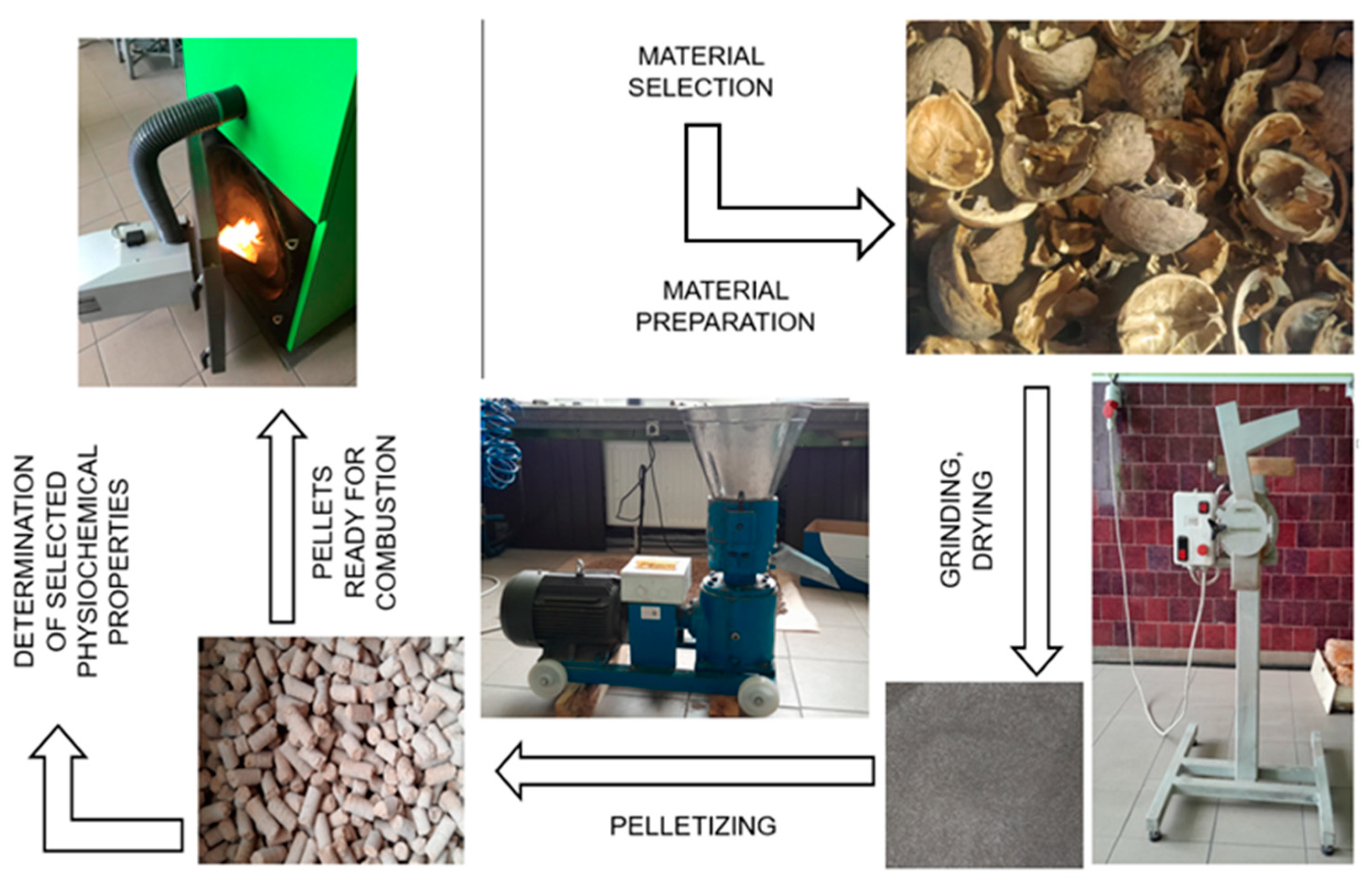
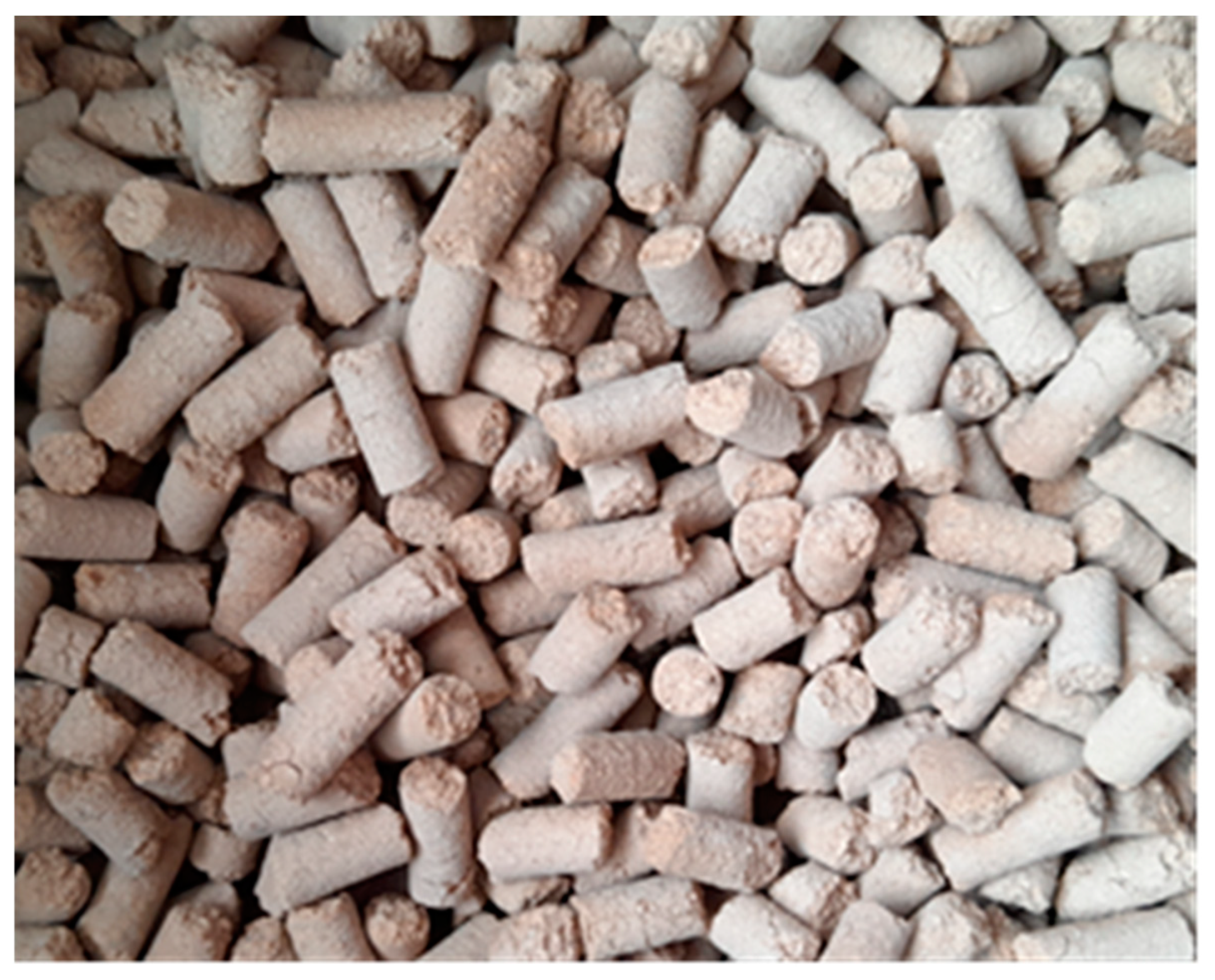
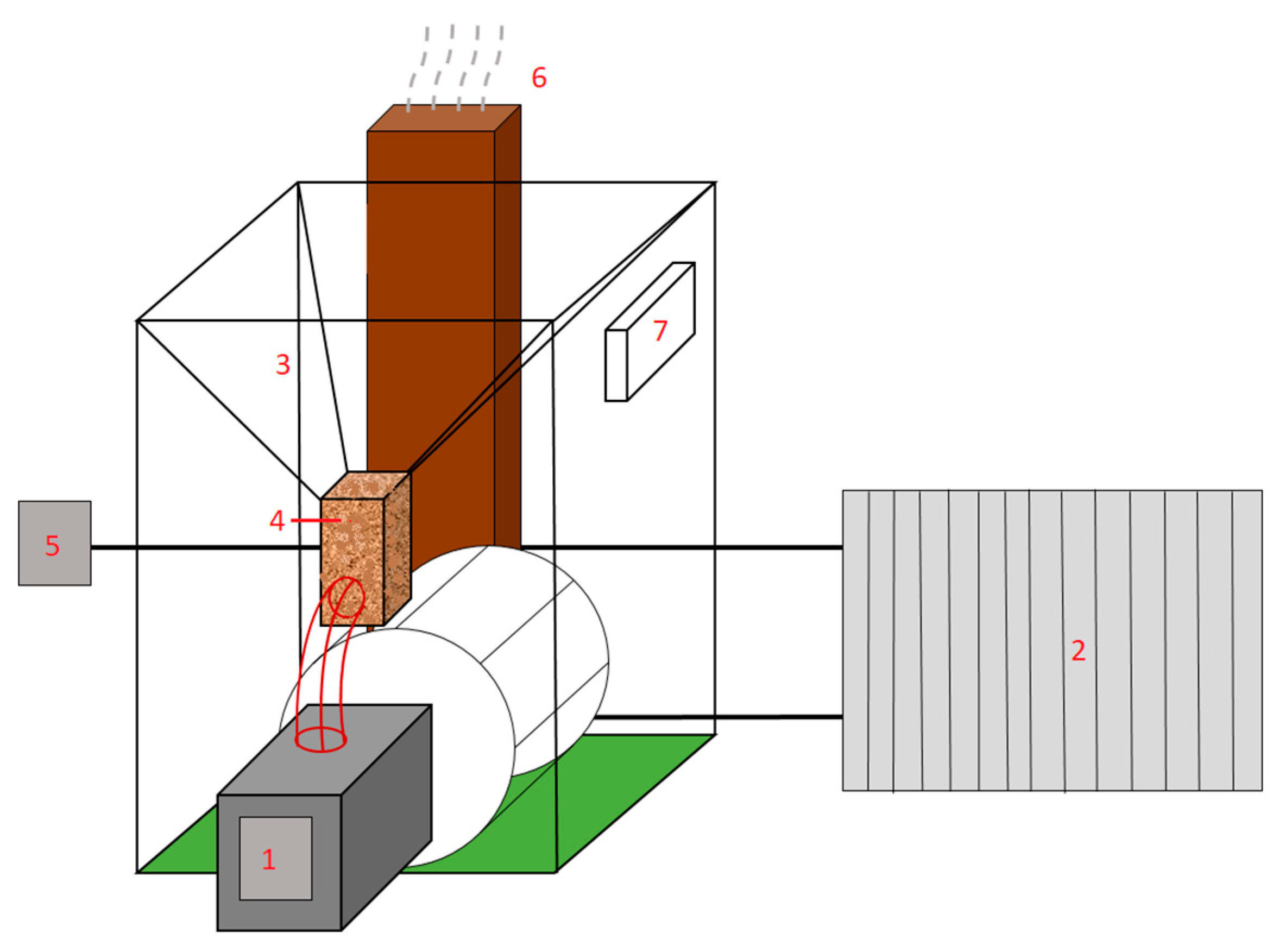
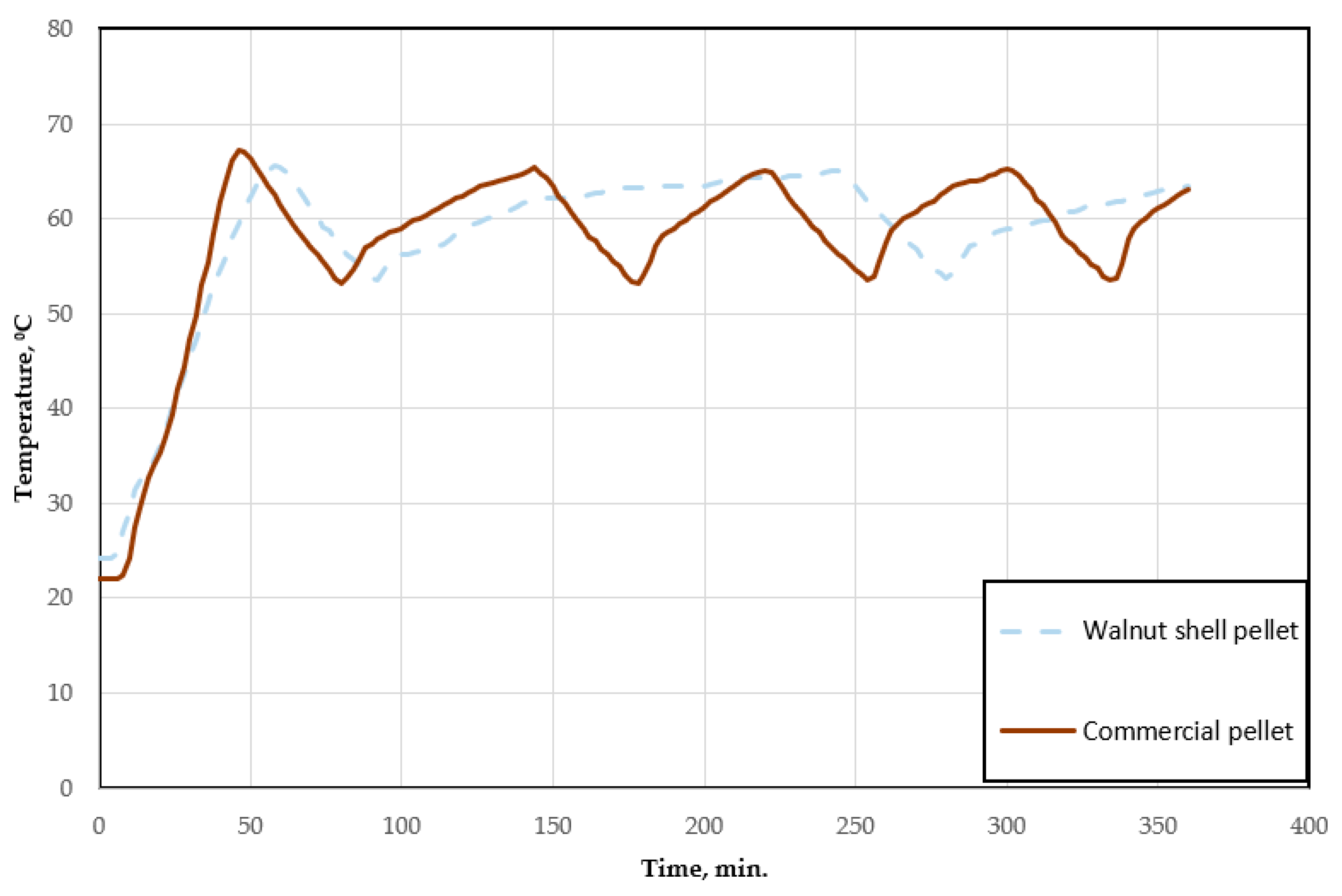
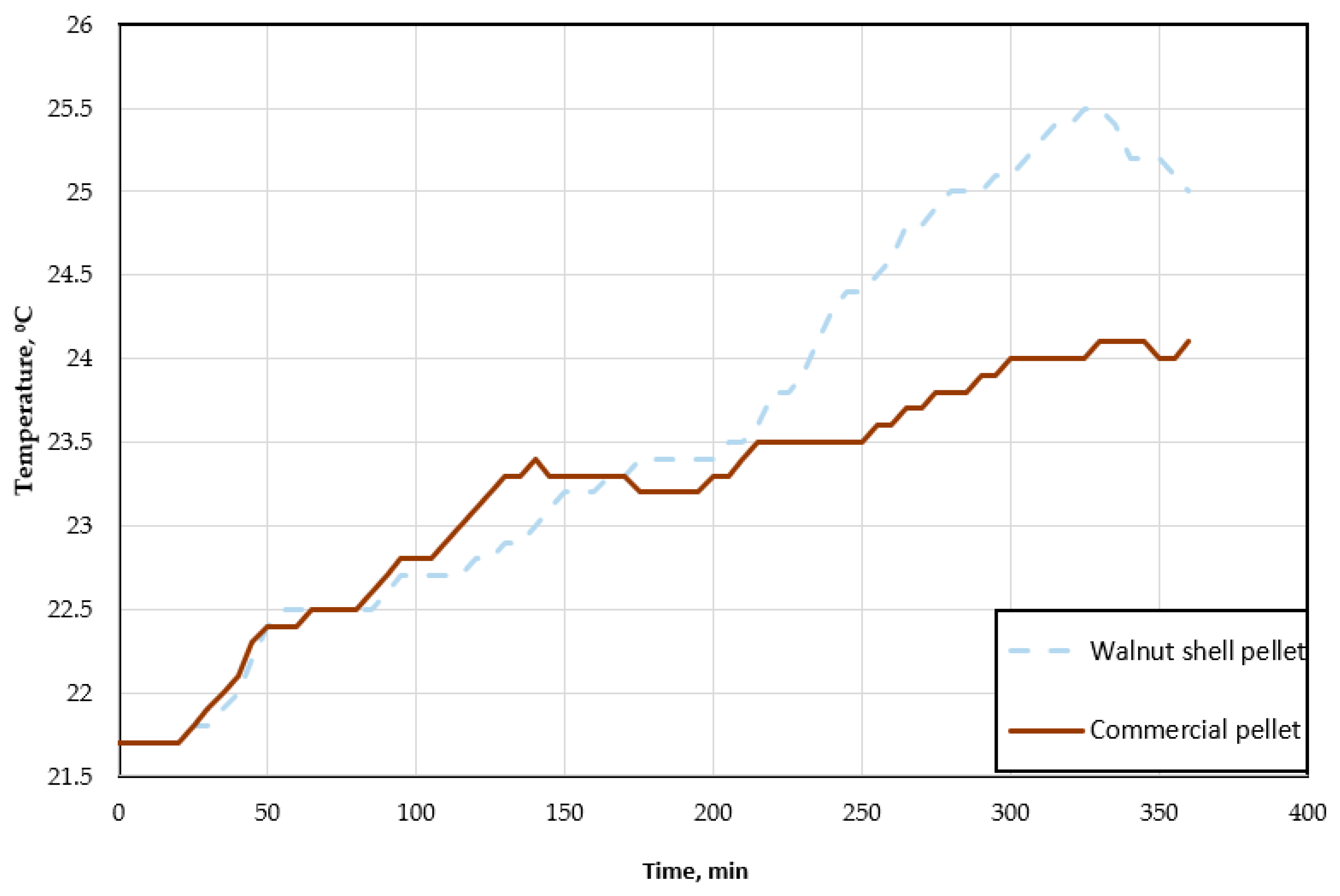

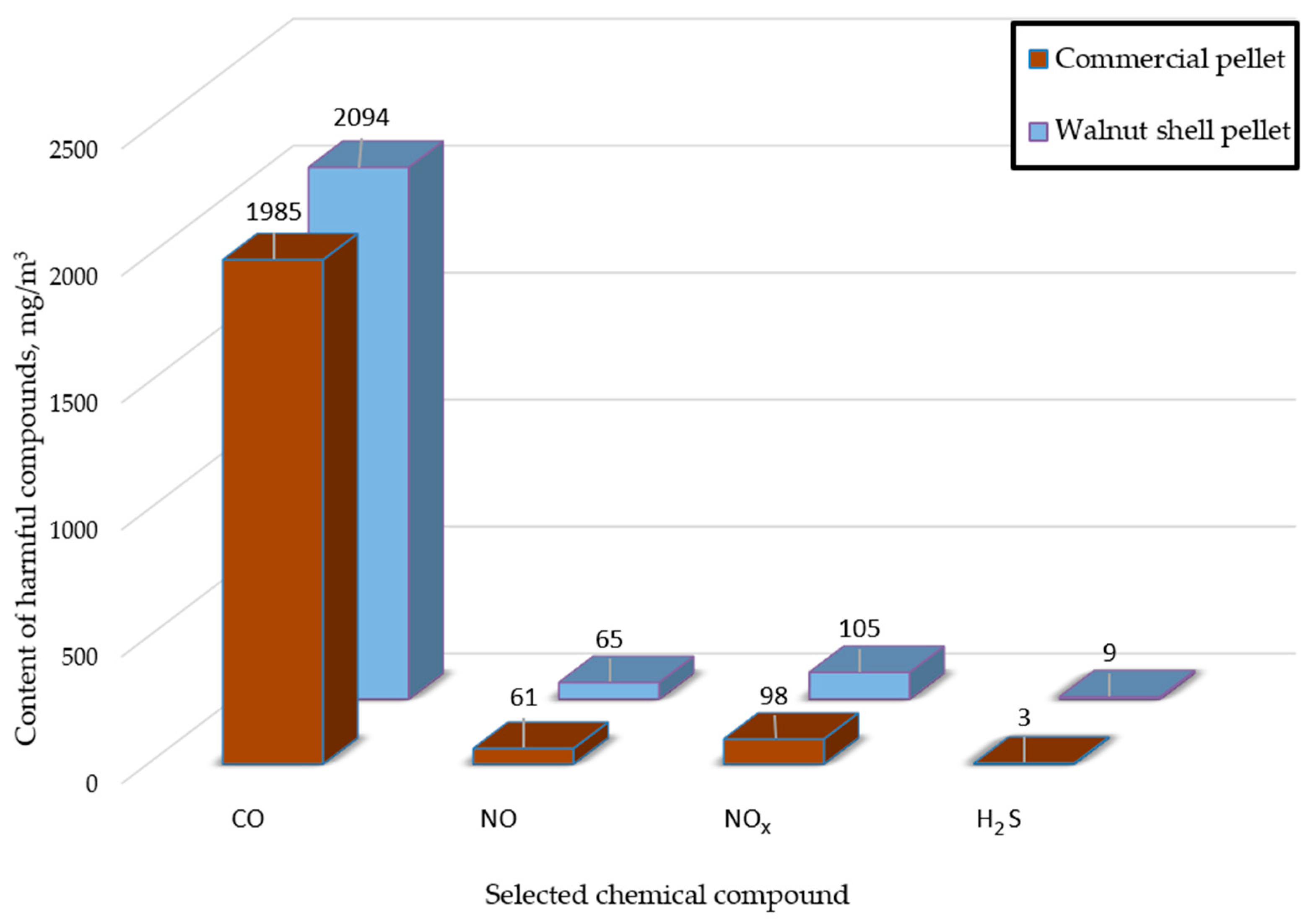
| Drying Time (min) | Drying Temperature (°C) | Analytical Calorific Value Qia (MJ/kg) | Analytical Heat of Combustion Qsa (MJ/kg) |
|---|---|---|---|
| 30 | 90 | 18.28 ± 0.07 | 19.51 ± 0.06 |
| 110 | 18.29 ± 0.13 | 19.52 ± 0.12 | |
| 130 | 18.35 ± 0.09 | 19.57 ± 0.10 | |
| 60 | 90 | 18.33 ± 0.15 | 19.55 ± 0.16 |
| 110 | 18.40 ± 0.02 | 19.62 ± 0.02 | |
| 130 | 18.21 ± 0.23 | 19.44 ± 0.22 | |
| 90 | 90 | 18.51 ± 0.09 | 19.74 ± 0.09 |
| 110 | 18.73 ± 0.12 | 19.96 ± 0.12 | |
| 130 | 18.05 ± 0.14 | 19.28 ± 0.14 |
| Selected Physiochemical Property | Walnut Shell Pellets | Limits According to PN-EN ISO 17225-6 Standard [60] | Commercial Pellets | Limits According to PN-EN ISO 17225-2 Standard [61] |
|---|---|---|---|---|
| Moisture content Mad (%) | 8.25 | ≤15 | 8.05 | ≤10 |
| Ash content Ad (%) | 1.31 | ≤10 | 1.45 | ≤2 |
| Volatile content Vd (%) | 77.72 | - | 83.51 | - |
| Analytical heat of combustion Qsa (MJ/kg) | 18.17 | - | 18.07 | - |
| Analytical calorific value Qia (MJ/kg) | 16.90 | ≥14.5 | 16.81 | ≥16.5 |
| Element (%) | Walnut Shell Pellets | Commercial Pellets |
|---|---|---|
| C | 47.80 ± 0.40 | 47.09 ± 0.15 |
| H | 6.20 ± 0.07 | 6.30 ± 0.02 |
| N | 0.92 ± 0.02 | 0.15 ± 0.02 |
| S | 0.1 ± 0.01 | 0.11 ± 0.01 |
| O | 35.41 ± 0.35 | 36.86 ± 0.13 |
| Other | 9.56 | 9.50 |
Disclaimer/Publisher’s Note: The statements, opinions and data contained in all publications are solely those of the individual author(s) and contributor(s) and not of MDPI and/or the editor(s). MDPI and/or the editor(s) disclaim responsibility for any injury to people or property resulting from any ideas, methods, instructions or products referred to in the content. |
© 2025 by the authors. Licensee MDPI, Basel, Switzerland. This article is an open access article distributed under the terms and conditions of the Creative Commons Attribution (CC BY) license (https://creativecommons.org/licenses/by/4.0/).
Share and Cite
Nabiałczyk, M.; Bala-Litwiniak, A.; Musiał, D.; Szymanek, A. Walnut Shell Pretreatment in Regard to Its Combustion Properties. Materials 2025, 18, 1208. https://doi.org/10.3390/ma18061208
Nabiałczyk M, Bala-Litwiniak A, Musiał D, Szymanek A. Walnut Shell Pretreatment in Regard to Its Combustion Properties. Materials. 2025; 18(6):1208. https://doi.org/10.3390/ma18061208
Chicago/Turabian StyleNabiałczyk, Michał, Agnieszka Bala-Litwiniak, Dorota Musiał, and Arkadiusz Szymanek. 2025. "Walnut Shell Pretreatment in Regard to Its Combustion Properties" Materials 18, no. 6: 1208. https://doi.org/10.3390/ma18061208
APA StyleNabiałczyk, M., Bala-Litwiniak, A., Musiał, D., & Szymanek, A. (2025). Walnut Shell Pretreatment in Regard to Its Combustion Properties. Materials, 18(6), 1208. https://doi.org/10.3390/ma18061208






